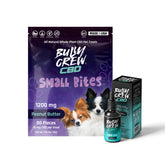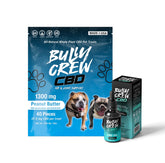Is vegetable glycerin safe for dogs? This is a question many pet owners have. As you carefully read labels on food, treats, and supplements, seeing an ingredient you're unsure about can be a source of worry. This guide provides clear and simple information about vegetable glycerin, including what it is, why it is used, and what to look for when choosing products for your pet. Our goal is to empower you to be a confident and informed pet owner, making choices that are safe and beneficial for your dog's health and happiness.
What Is Glycerin?
Glycerin is a naturally occurring compound. Chemically, it's known as a polyol, which is a type of sugar alcohol. It is a thick, sweet liquid that has no color or smell. You can find glycerin in many products, from food and medicine to cosmetics and soap. Its ability to attract and hold moisture makes it a beneficial ingredient for keeping things from drying out.

Glycerin can come from three primary sources, and it's essential to know the difference:
-
Animal fats: This type of glycerin is a byproduct of making soap from animal sources.
-
Petroleum: In some industrial processes, glycerin can be made from petroleum byproducts. This version is not used in food.
-
Plant oils: This is the source for vegetable glycerin. It is created from plant-based fats.
For products meant for pets, vegetable glycerin is the most common and preferred type. This is because it is a plant-based ingredient and is typically processed to a high food-grade standard.
What Is Vegetable Glycerin?
Vegetable glycerin is a type of glycerin derived from plant sources. It is created through a process called hydrolysis. This process involves heating vegetable fats, typically derived from oils such as coconut, palm, or soybean oil, under high pressure. This breaks down the oils into glycerin and fatty acids. The glycerin is then purified to a high standard, making it safe for use in food.
This plant-based origin makes vegetable glycerin a popular choice for pet products. It has a neutral taste, is non-toxic, and works well to hold moisture, which are all key qualities for a good ingredient.
Is Vegetable Glycerin Safe for Dogs?
The short answer to the question is yes, vegetable glycerin is safe for most dogs when used in the right amounts. This is a topic that has been well-studied and is supported by official sources.
FDA's Seal of Safety: GRAS Status
The U.S. Food and Drug Administration (FDA) has given vegetable glycerin a special status. It is listed as generally recognized as safe (GRAS) for use in food and supplements for both people and pets. This is a crucial indicator of safety. It means that, based on extensive scientific data and expert opinion, vegetable glycerin is considered safe for its intended use when it is made to a high-quality, food-grade standard.
Understanding Sugar Alcohol
A key reason it is safe is that it is a sugar alcohol. This can be a confusing term, but it simply means that while it has a sweet taste like sugar, it is not processed by the body in the same way. It is not absorbed in the small intestine, so it does not cause a sudden increase in blood sugar levels. This makes it an excellent option for all dogs, including those with conditions like diabetes who need to watch their blood sugar. Unlike high-fructose corn syrup or regular table sugar, vegetable glycerin does not pose the same health risks to dogs.
We can say that vegetable glycerine for dogs is safe because of these scientific facts. It is also a safe alternative to alcohol-based tinctures, which can be harsh on a dog's system. For liquid supplements, using glycerin as a base ensures the product is gentle and well-tolerated.
Why Brands Use Vegetable Glycerin in Pet Products
Vegetable glycerin is not just a filler ingredient; it is a beneficial ingredient for pet products. Its unique properties solve several practical problems for manufacturers, ensuring the products are high-quality and safe. The many vegetable glycerine uses are a big reason why it is so popular.
-
To Improve Taste: Vegetable glycerine for dogs has a sweet taste that helps hide strong or bitter flavors in supplements and medications. This is especially useful for pet products that contain herbal extracts, vitamins, or other ingredients that might not taste good on their own. The glycerin makes the product much more palatable, which means it's easier to give to a picky dog.
-
To Keep Products Soft: It is a humectant, which means it attracts and holds onto moisture. This is why it is used in soft chews and jerky-style treats. It keeps them from drying out and becoming hard, so they stay fresh and appealing for longer. This is also important for older dogs that may have dental issues and need a softer treat.
-
To Keep Products Fresh: It naturally helps to stop the growth of microbes like bacteria and mold. This acts as a natural preservative, which helps products stay fresh and safe for a longer time without needing strong artificial preservatives. It's a clean and secure way to extend the shelf life of a product.
-
To Keep Products Stable: In liquid supplements, all the ingredients must stay evenly mixed. Vegetable glycerin helps to keep the texture and consistency of liquid products stable so that the ingredients do not separate or settle at the bottom over time. This ensures that your dog gets a consistent dose of all the active ingredients with every serving.
You will find vegetable glycerin in a wide range of pet products, from soft chews and liquid supplements to topical grooming products.
What to Look for When Choosing a Product
The quality and source of vegetable glycerin can vary. As a pet owner, being a smart consumer means knowing what to look for on a product label.
Potential Side Effects
When used in the right amounts, vegetable glycerin is well-tolerated by most dogs. However, suppose a dog eats a huge amount. In that case, more than is recommended on the label, it could have a temporary laxative effect. This might cause temporary digestive upset, such as loose stool or gas. These effects are rare and typically occur due to overconsumption. Always follow the feeding instructions on the product label.
The Source and Quality of the Ingredient
Not all vegetable glycerin is made the same way. The quality and source are essential.
-
Organic, Plant-Based Sources: The best vegetable glycerin is derived from organic, plant-based oils, such as coconut or non-GMO corn. A brand that specifies this on the label is being transparent and has likely used a high-quality ingredient.
-
Questionable Sources: Lower-quality glycerin can come from non-organic crops that have been treated with pesticides. It can also be derived from unsustainably sourced palm oil, which has a detrimental impact on the environment. Some industrial-grade glycerin is not intended for consumption and may contain impurities that are not safe.
-
The Food-Grade Standard: Always look for a label that says the product is food-grade or human-grade. This means the glycerin has been processed to a high standard of purity, making it safe for consumption.
-
Transparency from Brands: A reputable company will be open about where its ingredients come from and how its products are made. If you have questions about the glycerin they use, contact the manufacturer and ask about their sourcing.
Third-Party Lab Testing
For supplements like CBD, a Certificate of Analysis (COA) from an independent lab is essential. This report provides an exact breakdown of the product's contents. It will verify the amount of CBD and other ingredients and confirm that it is free from harmful things like heavy metals, pesticides, and molds. A COA is a crucial step in verifying the quality and purity of a product.
Conclusion
So, is vegetable glycerin safe for dogs? Yes, it is a useful and safe ingredient in pet wellness products. It is a simple, plant-based compound that helps make treats and supplements taste good, stay fresh, and maintain their quality.
The most important takeaway is that the source and purity of the glycerin are what matter most. By looking for brands that are transparent about their sourcing, use organic ingredients, and provide third-party lab testing, you can make sure you are choosing safe and high-quality products for your dog. A careful consumer is the first step in providing your pet with a healthy and happy life.







